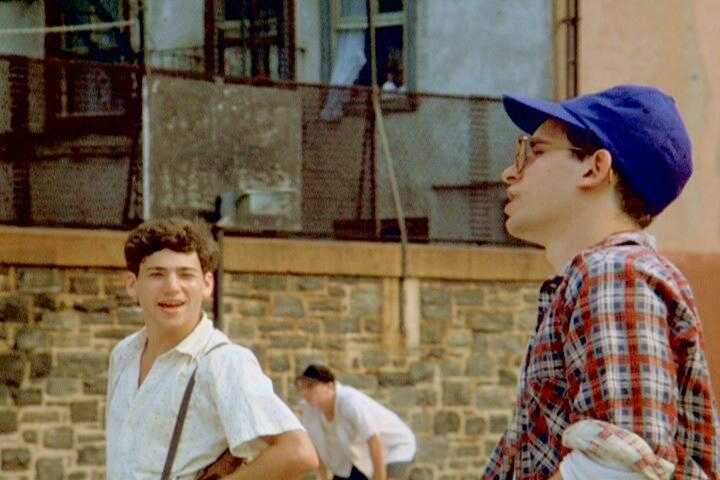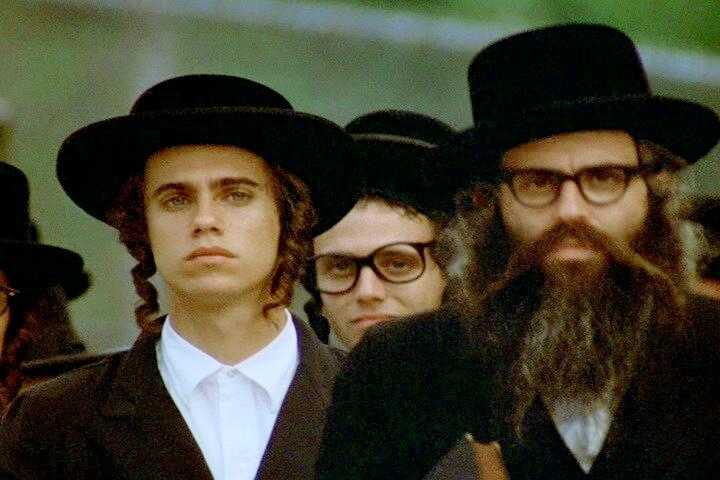
The Chosen (U.S., 1981)

Figure 1.-- The clothing worn by the two boys and the two cultures out of which they emerge is very accurately depicted. The most revealing scene in terms of the boys' clothes occurs at the beginning during a local baseball game in which the secular boys play the Hasidic boys. The secular boys wear jeans or trousers, often held up by clip-on suspenders. Reuven, who is the pitcher for his side, wears a white long-sleeved jersey underneath a plaid, unbuttoned flannel shirt. Most of the secular boys wear sneakers and a few wear baseball caps.
|
Chaim Potok's novel about a friendship which developed between two youths coming from two very different Jewish traditions. One boy is a worldly, assimilated Jew and the and other an extremely observant Hasidic rabbi in the years following World War II. The boys are all older teenagers. Robby Benson does give an impressive performance as does the boy playing the Hasidic teenager. The film persues the relationship between the two teenagers.
It's an absolutely charming film--both moving and funny by turns. And the acting of the two boys is just superb. It also illustrates the somewhat
unusual dress of Hasidic Jewish boys in New York during the 1940s as well as
the dress of teenage boys who are a bit less religiously oriented. It's a
remarkable record of period boys' dress. The two boys are 16-17 years old,
highschoolers.
Filmology
"The Chosen" is based on a Chaim Potok nove and directed by Jeremy
Kagan.
Setting
The film is set in New York City during the years following World War II.
Cast
The two boys are 16-17 years old, highschoolers. The film tells the story of the complex relationship between two teenage boys (they are about 17 years old)--Danny Saunders and Reuven Malter--who come from very different traditions of Judaism. The film is splendidly acted. The two boys are played by Robby Benson (Danny) and Barry Miller (Reuven). Robby Benson does give an impressive performance as does the boy playing the secular teenager. Reuven's father, the professor, is played very sensitively by Maximilien Schell. Rod Steiger is equally convincing as the wise but very conservative rabbi who puts all his hope on his son Danny. Both boys are budding intellectuals (like their fathers) but are pulled in different directions (conservative and liberal) by their fathers.
Plot
The film is about a friendship which developed between two youths coming from two very different Jewish traditions. One boy is a worldly, assimilated Jew and the and other an extremely observant Hasidic Jew. The film persues the relationship between the two teenagers. It's an absolutely charming film--both moving and funny by turns. Danny's father is an ultraconservative
rabbi so the boy is brought up in an extremely devout, isolated community of
Hasidic Jews who are highly conservative in dress and belief. Danny is a brilliant boy and
expected to continue the rabbinic profession and leadership of his father's brand of Judaism when he comes of age. Reuven is also very bright, but is the son of a college professor whose approach to Judaism is much more secular and who holds very progressive ideas about the faith. The two boys meet in a local baseball lot becoming close friends, and each boy gets exposed to the traditions and way of life of the other with some alienation but also with much respect. Reuven, for instance, dresses like a normal secular New York teenager, whereas Danny continues to wear the black clothes and the dreadlocks of the Hasidim. Each boy meets and is influenced by the other's father. The film very beautifully portrays a Jewish teenager's respect for and love of his father, at the same time undergoing experiences that make him want to break away from that tradition. At the end of film, Danny, who has been exposed to the broader cultural influences (secular novels, museums, movies, etc.) through his friendship with Reuven ultimately rejects the path his rabbinic father has chosen for him--but the break is a painful and moving one.

Figure 2.-- The Hasidic boys are more or less in religious uniform--black suits worn over white dress shirts without neckties but buttoned up to the neck, and long coats sometimes. They all wear black suspenders, and some of them wear prayer shawls. They also wear their hair long with curled dreadlocks under yamulkas on top of which they wear black felt brimmed hats when they are outdoors.
|
Israel
One interesting side theme is how American Jews were coming to terms with the NAZI holocaust. Many had family in Europe and they were terrified as years went by without words. When Allied armies entered Germany and the Soviets Poland the world was horified to find the full extent of NAZI barbarity. Another issue becomes Israel and different attigtudes among Jews about a Jewish homeland in Palestine.
Costuming
It also illustrates the somewhat
unusual dress of Hasidic Jewish boys in New York during the 1940s as well as
the dress of teenage boys who are a bit less religiously oriented. It's a
remarkable record of period boys' dress. The clothing worn by the two boys and the two cultures out of which they emerge is very accurately depicted. The most revealing scene in terms of the boys' clothes occurs at the beginning during a local baseball game in which the secular boys play the Hasidic boys. The secular boys wear jeans or trousers, often held up by clip-on suspenders. Reuven, who is the pitcher for his side, wears a white long-sleeved jersey underneath a plaid, unbuttoned flannel shirt. Most of the secular boys wear sneakers and a few wear baseball caps. The Hasidic boys are more or less in religious uniform--black suits worn over white dress shirts without neckties but buttoned up to the neck, and long coats sometimes. They all wear black suspenders, and some of them wear prayer shawls. They also wear their hair long with curled dreadlocks under yamulkas on top of which they wear black felt brimmed hats when they are outdoors.
HBC

[Return to the Main alphaberical Cf-Ch movie page]
[Return to the Main U.S. movie page]
[Introduction]
[Activities]
[Biographies]
[Chronology]
[Clothing styles]
[Countries]
[Girls]
[Theatricals]
[Bibliographies]
[Contributions]
[Essays]
[FAQs]
[Glossaries]
[Satellites]
[Tools]
[Boys' Clothing Home]
Created: 2:17 AM 1/26/2006
Last updated: 2:17 AM 1/26/2006




